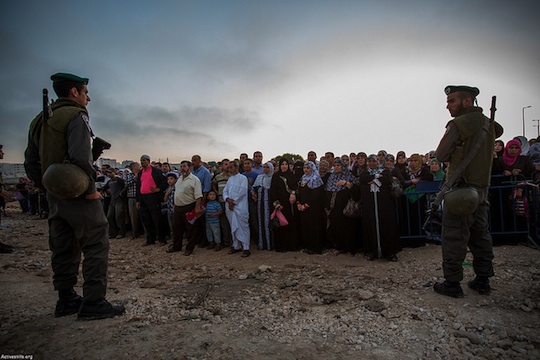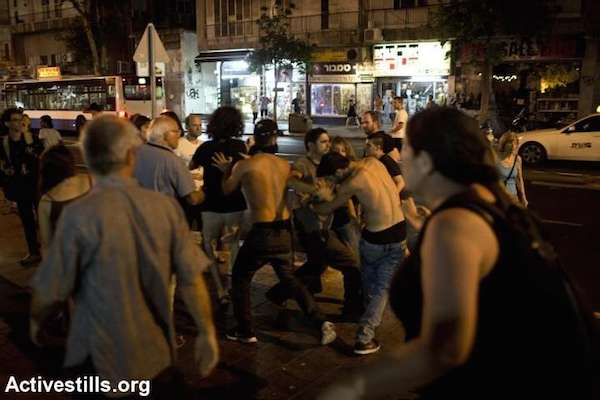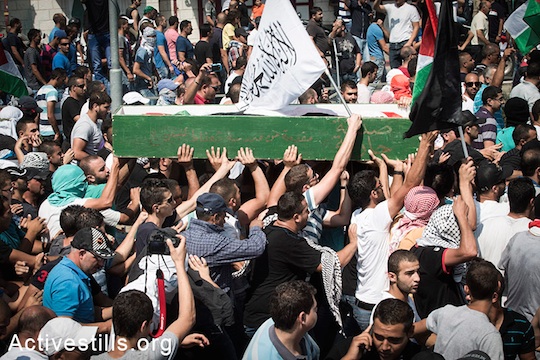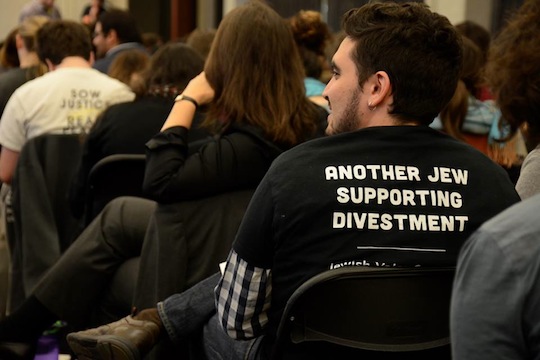The Gaza war was a clear choice for +972’s selection as story of the year (read it here). But the other nominated stories need to be told, too. +972 bloggers explain why they made their nominations. From the kidnappings to a new paradigm for Jewish-Arab relations to a growing opposition among U.S. Jews.
The kidnap-murder of three Israeli teenagers
By Larry Derfner

As of June 12, Hamas had not fired a rocket into Israel for more than a year-and-a-half. Since the start of 2014, one Israeli had been killed in a Palestinian attack in the West Bank, while 22 Palestinian protesters and bystanders (not counting armed militants) had been killed by Israeli troops. The big political story was the Fatah-Hamas reconciliation, a Palestinian political triumph that the world cautiously welcomed and that Netanyahu was unsuccessfully using to try and shift the blame for the failed Kerry talks from himself to Abbas, and to hold off the expected Palestinian diplomatic onslaught in the UN. As of June 12, Mohammed Abu Khdeir was alive. The streets of Galilee and East Jerusalem were quiet, while those of the West Bank and Gaza Strip were about as quiet as they get.
At 10:15 that night at a West Bank bus stop, two Palestinians in a car gave a lift to three hitchhiking Israeli teenagers, Naftali Fraenkel, Gilad Shaer and Eyal Yifrah, and everything changed. Blaming Hamas for the abduction (though Israeli officials later acknowledged that Hamas leaders in Gaza didn’t know about the kidnapping in advance, and that it was carried out by a renegade, Hebron-area Hamas cell known for its independent acts of terror), Netanyahu ordered the army to lay siege to Hebron and the vicinity. Abbas’ Palestinian Authority troops cooperated. Several Palestinian protesters were killed and hundreds of Hamas members were arrested, including some 60 who’d been released in the Gilad Shalit prisoner exchange. In reaction, Hamas relaxed its restraint on Gazan militant groups, which ratcheted up their rocket fire into Israel, and Israel fired back more heavily and much more accurately. By this time, the Fatah-Hamas reconciliation was in tatters.
On June 30th, the three teenagers’ bodies were discovered in the West Bank. Anti-Arab attacks, especially in Jerusalem, that had been sparked by the kidnappings escalated. On July 2, Israeli Jews kidnapped Mohammed Abu Khdeir, 16, on the capital’s eastside and burned him alive. Riots broke out in East Jerusalem and Galilee; the violence in Jerusalem continued for months, centered on the explosive Temple Mount, and high tension remains.
Meanwhile, the aerial exchanges between Israel and Gaza had escalated, with Hamas eventually joining the fray. On July 8 Israel launched Operation Protective Edge. That war, Abu Khdeir’s killing, the violence in Jerusalem, Galilee and the West Bank, the abortive end to Palestinian unity, and the descent to new depths of Jewish-Arab fear and hatred were all set in motion at 10:15 p.m., June 12, at a West Bank bus stop.
The year the status quo’s price became clear
By Noam Sheizaf

When 2014 began, Israel was led by a government that concentrated on housing prices and promised to raise the public’s standards of living; U.S. Secretary of State John Kerry led a diplomatic initiative which was designed to lead to a breakthrough on the Palestinian front, and Prime Minister Netanyahu was still being treated by the media as “King Bibi” – the title of a 2012 TIME Magazine cover – with no likely challenger anywhere in sight.
By spring, the diplomatic initiative collapsed. The kidnapping and murder of three Israeli teens led to the largest military campaign in the West Bank since the Second Intifada. The lynching of a Palestinian teen caused unprecedented fear and anxiety among Palestinian citizens of Israel. In July, Israel launched its third – and deadliest – military campaign in Gaza. At least 2,100 Palestinians and 72 Israelis were killed. The final months of the year saw a rise in protests in East Jerusalem. There were also attacks against Israeli civilians – four were murdered in a Jerusalem synagogue – and a significant rise in Palestinian casualties in the West Bank. Forty-four were shot to death by the IDF, including 11 children and teens.
Secretary Kerry’s peace mission failed because he refused to acknowledge the reality on the ground – the asymmetry between the sides, the fact that Israelis welcomed the so-called status quo while Palestinians can’t live with it. And he refused to address the most banal truth of them all: this is not a diplomatic issue, but a civil rights one. Kerry thought he was trying to get a peace deal. In reality, he was attempting to convince a reluctant Israeli leadership to give Palestinians some of their basic human and civil rights.
Netanyahu promised Israelis prosperity and peace without dealing with the Palestinian issue, and the public bought it — enthusiastically. 2014 taught us that there is nothing static in the status quo. The only way to keep millions of people in besieged Gaza, to maintain more millions in the West Bank under an oppressive military regime, and to enable the hoax of “unified Jerusalem,” the capital of “democratic Israel” in which one-third of the population is deprived of full civil rights – the only way to do all that is by force. Faced with the choice between change and war, Israel kept going for the latter.
2014 was a terrible year. If one needs to find some silver lining in it, it’s that all the masks have come off.
New opposition arises among U.S. Jews
By Noa Yachot
Is the Israel-shaped blind spot plaguing Americans shrinking? Maybe. A poll taken during this summer’s war in Gaza found that young Americans were much less supportive of Israel’s offensive than their elders. And while most U.S. Jews – 80 percent, according to a J Street poll – approved of the war, the minority made its voice heard.
Especially among young people, dissent from within the Jewish community had new outlets in 2014. If Not Now, a new group comprised partially of former J Street leaders, drew on Jewish tradition to protest the war around New York City. Hundreds attended a conference organized by Open Hillel, a movement challenging Hillel International’s strict guidelines for Israel-related activities on American campuses. Jewish Voice for Peace saw a dramatic surge of support, resulting in more than a dozen new chapters. Its Facebook followership grew from 57,000 at the start of the war to nearly 200,000 today.
This new opposition hasn’t arisen from an emerging consensus within the U.S. Jewish establishment regarding the injustice of the occupation. On the contrary. The establishment’s zero tolerance policy on criticizing Israel has only hardened. J Street’s rejection earlier this year by the Conference of Presidents of Major American Jewish Organizations was a powerful reminder of what – and who – the Jewish establishment considers acceptable. Rabbis continue to fear expressing their opinions on Israel to their congregants.
This establishment still holds the keys to power. But it may no longer have a monopoly on the debate. A new patchwork of opposition has popped up, and at some point, if the old guard wants to remain relevant, it will have to listen.
Incitement against the Left reaches new heights
By Mairav Zonszein

This year was the year that incitement against Palestinians, a well-known phenomenon among Israelis, crossed over into incitement against the minority Jewish left in Israel. The catalyst was the war in Gaza, which seemed to give Israelis carte blanche to attack those who criticized the war, unleashing a new level of intolerance and aggression towards dissenting opinions.
At the first protest against the war on July 12 in central Tel Aviv demonstrators were attacked by a group of rightists chanting “death to leftists.” Several were badly injured and the police did nothing.
Celebrities who voiced any level of criticism against Israel were chastised – from veteran actress Gila Almagor, who received death threats, to comedian Orna Banai, who was fired as spokesperson of an Israeli cruise line. A group of Kahanists harassed and in some cases physically attacked people who attended a show by an artist/dancer who reenacts movements of settlers and soldiers in the West Bank, using footage from Israeli human rights NGO B’Tselem.
Peace Now released a video campaign in November highlighting a selection of the hundreds of thousands of inciting comments it receives, calling it an epidemic.
Incitement against the Left is also apparent in the election campaign. Netanyahu is squarely campaigning on the message “We are not the left,” while Livni and Herzog who formed a new party for this election are steering clear of calling themselves left. Candidates to the right like Danny Danon and Ronen Shoval, who made a name for himself as founder of Im Tirztu and whose modus operandi is inciting against the Left — are campaigning on messages that portray Tzipi Livni and Peace Now as enemies of the state.
A new paradigm for Jewish-Arab relations in Israel
By Roi Maor

2014 has been a terrible year for Israel’s 1.7 million Palestinian citizens. Living inside the “Green Line” 1967 borders, they – unlike Palestinian residents of the West Bank and Gaza – are formally endowed with full civil rights. But in reality, they have always been marginalized, excluded and the targets of outrageous discrimination and oppression.
The need to maintain the facade of the “only democracy in the Middle East” has shielded Palestinian citizens to some extent: for example, they can vote and have representatives in the Knesset. In 2014, this limited protection was severely eroded.
The Gaza war, unlike the string of previous operations, was accompanied by a wave of animosity and violence towards Palestinian citizens. Public figures, who in the past have paid lip service to Israel’s egalitarian ideals, remained quiet or even egged on hatred and incitement (with the notable exception of new President Reuven “Ruby” Rivlin). A Palestinian Knesset member was suspended for an unprecedented six months, simply for voicing controversial opinions.
This course of events should be alarming to all those who care for the people in this land.
The brutal murder of Mohammed Abu Khdeir
By Edo Konrad

On the morning of July 2, Israel woke up to hear that a 16-year-old Palestinian was burned alive in a forest in Jerusalem overnight. By mid-day, false rumors abounded that Muhammad Abu-Khdeir was either killed by a rival Palestinian family, or by his own for being gay. The sheer brutality of the act was likely too much – Israelis needed an explanation that could allow them to assuage their greatest fear: that one of their own was responsible.
Abu Khdeir’s murder at the hands of three Israelis who claimed to seek revenge for the kidnapping and murder of Eyal Yifrah, Gilad Shaer and Naftali Frenkel two weeks prior came at a moment where gangs of Jewish Israelis roamed the streets seeking to mete out their own brand of vigilante justice. The incitement, which came not only from far-right elements in Israeli society, but from the highest echelons of its government, came to its logical conclusion at the expense of an innocent teenager walking to Ramadan prayers in the early hours of the morning. The chickens finally came home to roost.
But violence by Israeli civilians isn’t new to this society. Abu-Khdeir’s murder was so significant because it captured precisely how Israeli society prefers to view itself. In retrospect the outcry by well-intentioned people and the visits to the family mourner’s tent by politicians (former Environmental Protection Minister Amir Peretz received death threats for his visit) are nothing short of confounding, especially when we consider what came soon thereafter.
Just weeks later, Israel embarked on brutal assault on Gaza that would leave over 2,100 Palestinians dead, more than 500 of them children. Approval for the war reached unprecedented heights, and even most of the political parties aligned with the “Israeli left” took weeks to come out in opposition to the war. How can the same people condemn Abu Khdeir’s murder while letting slide the killing of 72 entire families in Gaza?
The Abu Khdeir murder revealed the arbitrary limits of what Israeli society will allow itself to take part in. It was a reminder that while Israelis may have little tolerance for “vigilante justice,” they are mostly complicit in the more “official” violence of the army and the defense establishment. Good intentions and visits to mourning tents are not enough. Let’s hope that 2015 is the year that Israeli society begins challenging not only its vigilante violence, but also its state-sponsored form.
Read more of +972′s year-end coverage:
The Year in Photos: Palestine-Israel in 2014
+972′s Story of the Year: Gaza
+972′s Editor’s Picks of 2014
The 25 most-read posts of 2014

